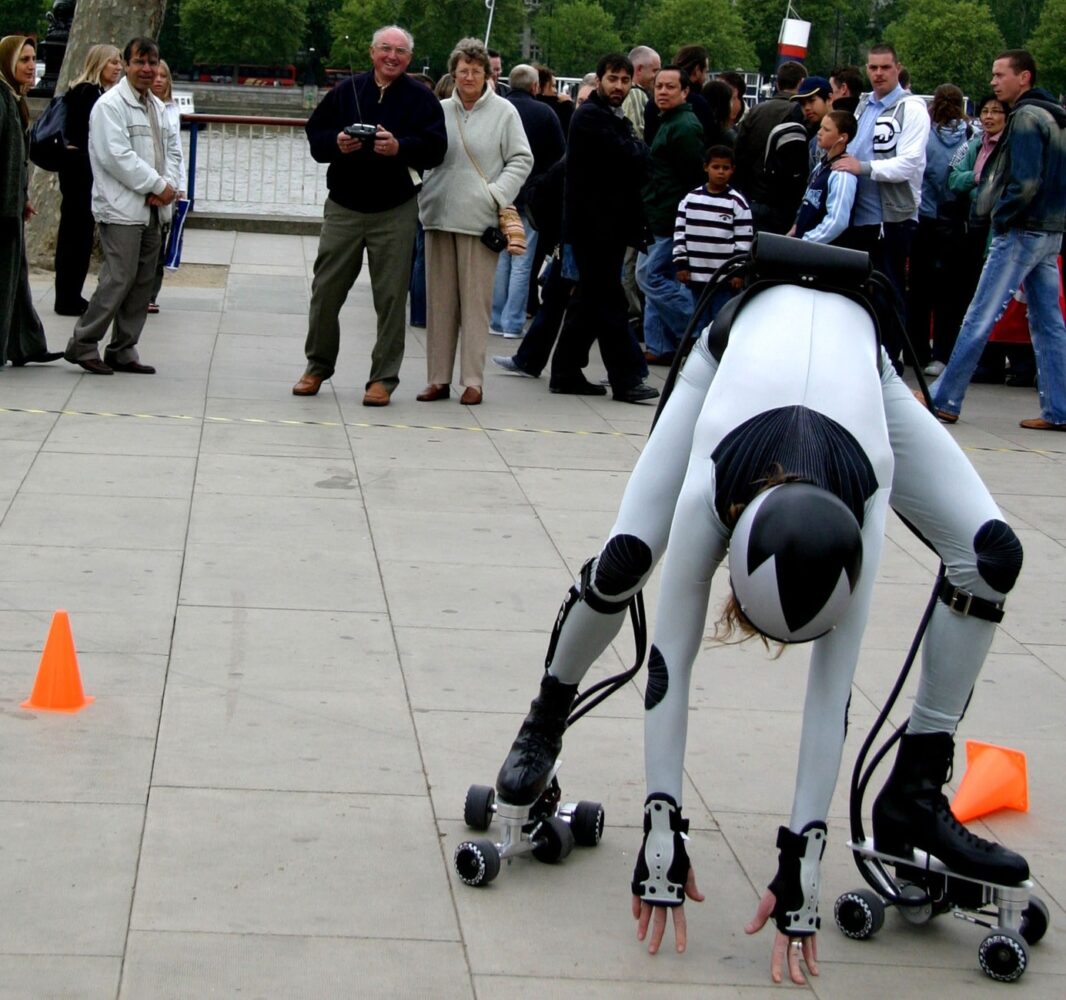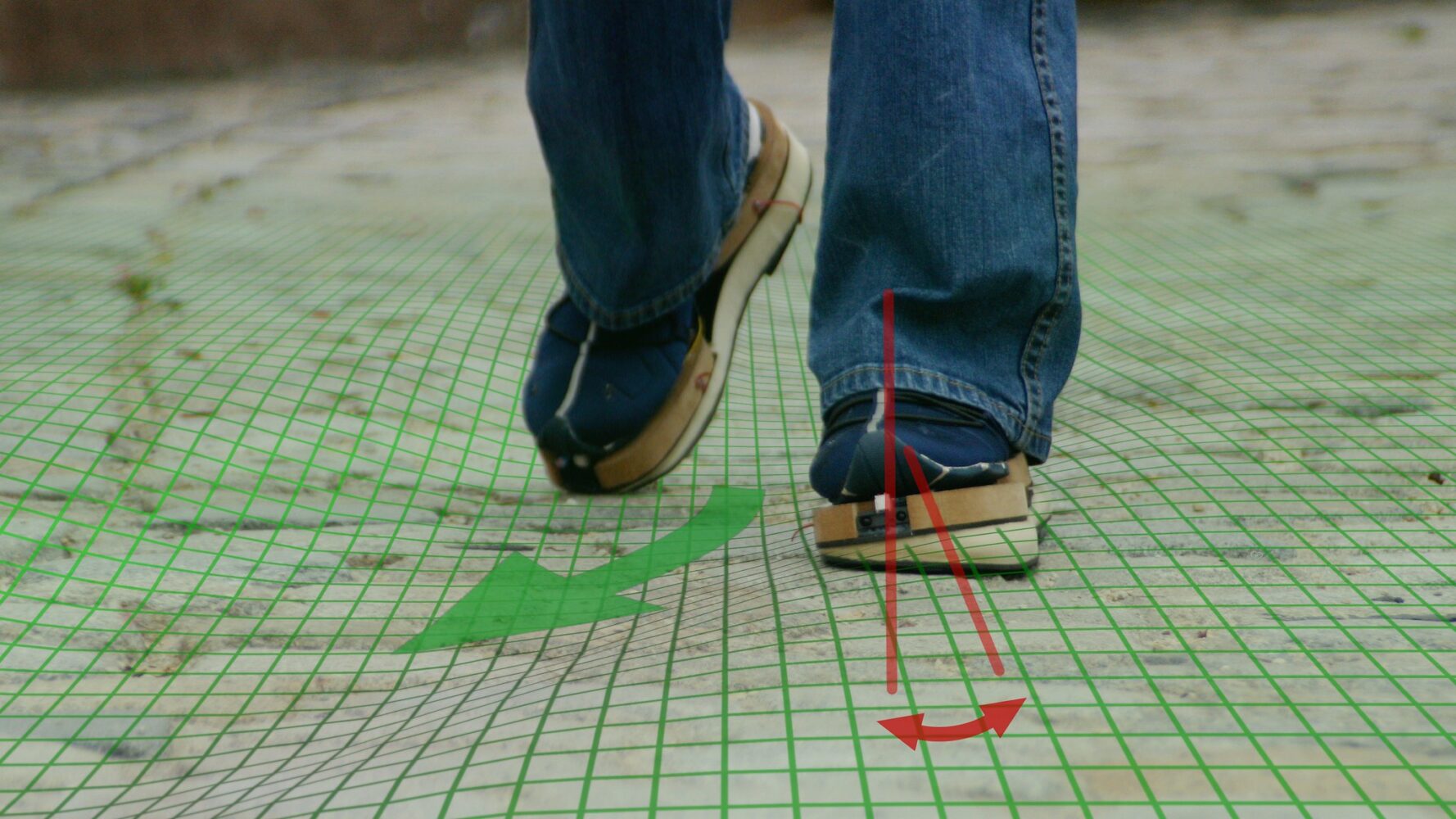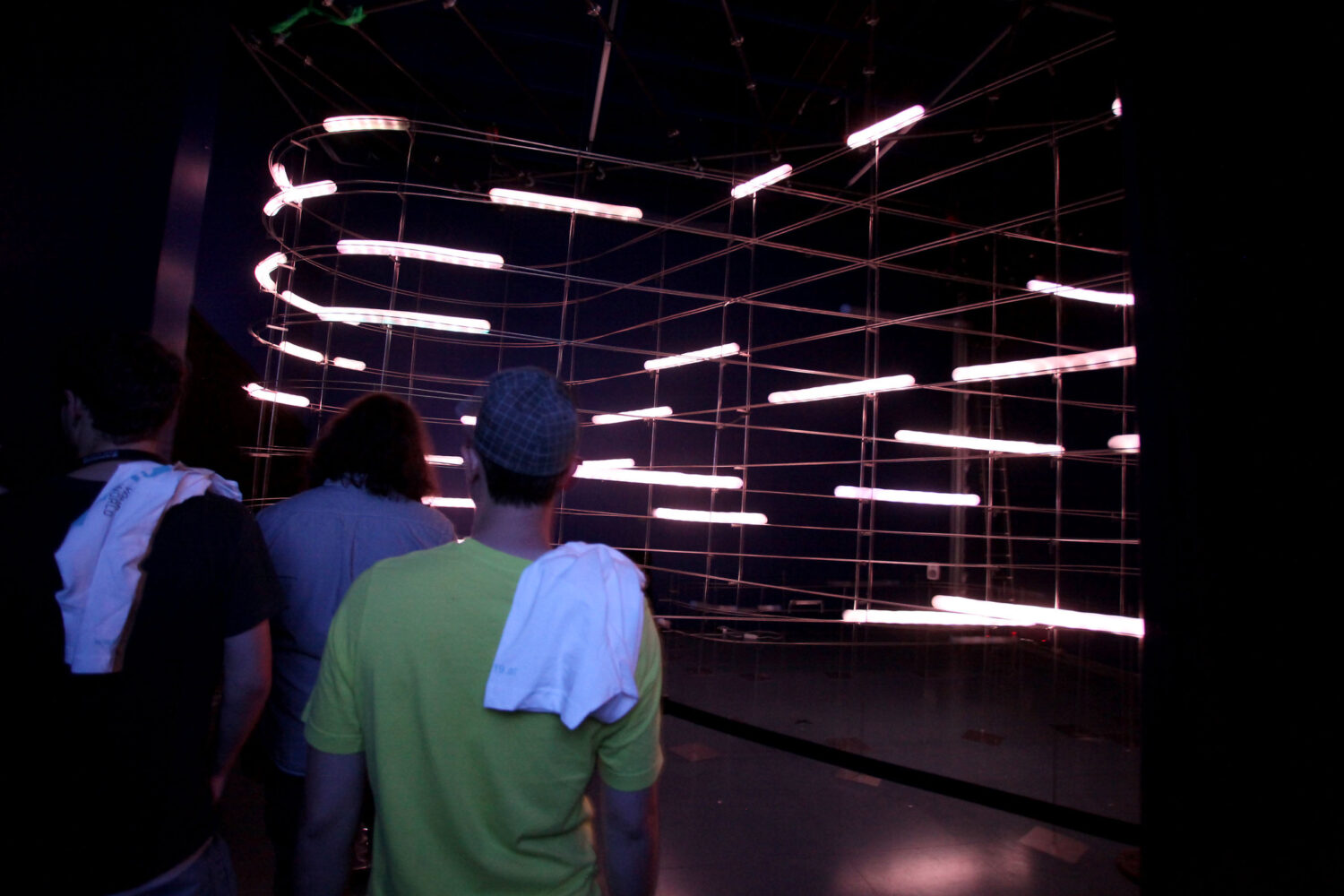Ars Electronica Export is invited again at Volkswagen AG in Berlin to show already for the third time outstanding artistic approaches, focussing on our “Zeitgeist” and mobility. On two different levels the showroom in Berlin will present 19 installations and documentations.
Type: Exhibition
Duration: 12.07. – 16.09.2012
City, Country: Berlin, Germany
Venue: Automobilforum Unter den Linden Volkswagen AG
In this third exhibition staged jointly by Ars Electronica and Volkswagen, the spotlight is focused on a balancing act between absolute self-determination and utter disenfranchisement. In it, the urban space as an extreme example of a living situation that is as real as it is elaborately construed is conceived as a laboratory for the development and testing of innovative strategies and approaches. Prizewinning works of art open up extraordinary spheres of association that range from philosophical reflection to the pursuit of self-awareness in real-world settings.

The city is unequalled by any of humankind’s other habitats as a manifestation of our modern world’s complexity. It evokes the many social, cultural and ethnic conflicts that cut across our society, as well as the feeling of a common bond among its inhabitants. Millions of people live and work together in metropolises, cognizant that nowhere else on earth do people exist in such close proximity and nevertheless have so many options to pursue their own individual lives and lifestyles.
None of our other habitats, in order to make peaceful coexistence possible at all, necessitates such a complex composition of how human beings live together—a set of rules that circumscribes every aspect of our lives but at the same time opens up behavioral latitude to the greatest extent possible. One that defines itself as a commitment to every person’s right of self-determination, but that also demarcates clear boundaries. However, this container, so to speak, that is the sum of all conceivable compromises must never be capped and sealed; it has to be understood as an ongoing process that is made to keep moving by applying one new impetus after another. If that doesn’t occur or does to an insufficient extent, resistance arises.
That such disobedience can develop a dynamism all its own is demonstrated by a trendy sport named parkour. Back in the 1990s, young people in certain Paris suburbs began to take a totally new approach to making their predominantly steel, concrete and glass environment their own. They declared conventional sidewalks to be off-limits and set off on their own paths—routes that always had to lead from Point A to Point B as quickly and directly as possible. In going about this, the traceurs (“trailblazers”) acrobatically overcome seemingly insurmountable barriers. In addition to intentionally disregarding prevailing rules, the traceurs highly esteem not damaging their surroundings. Parkour stands for responsible, independent behavior that is freed from regulations and that shows respect for the environment and for other human beings. Now, 20 years after it was invented, Parkour has long since ceased to be a youth movement in the banlieue; it’s a trendy urban sport that’s being promoted by the PR agencies of an international soft drink manufacturer.
A completely different strategy of attaining one’s objective is celebrated by American artist Joseph Herscher. He designs and builds giant machines to perform very specific tasks, whereby the jobs are generally rather simple matters whereas the devices to do them are about as complex as can be. Herscher’s contrivances are usually powered by tiny balls that, once they’re set in motion, collide with various obstacles and, in doing so, invariably trigger new motion. Impetus is followed by movement is followed by impetus is followed by movement.
Whether speedy and direct like a traceur or as circuitous and slow as Herscher, the path is the actual objective in both cases. As playful and effortless, as unfailing as these two seem to be in arriving at their respective destinations, a trifle is all it takes to send either of them careening out of equilibrium. And that’s also exactly what it is about them that enthralls us. Hovering above every act of surmounting an impediment, no matter how elegantly accomplished, is the possibility of failing in grandiose fashion.
In this third exhibition staged jointly by Ars Electronica and Volkswagen, the spotlight is focused on a balancing act between absolute self-determination and utter disenfranchisement. In it, the urban space as an extreme example of a living situation that is as real as it is elaborately construed is conceived as a laboratory for the development and testing of innovative strategies and approaches. Prizewinning works of art open up extraordinary spheres of association that range from philosophical reflection to the pursuit of self-awareness in real-world settings.
Artworks
Cantoni/Crescenti (BR)
Floor (2007)

Stepping on either end of this installation triggers a wave that slowly rolls down a 25-meter track. All that lies in its path is gently uplifted as the wave makes its way through the installation space.
Dash Macdonald (GB)
In Your Hands (2008)

The roller skates Dash MacDonald dashes about on aren’t the kind you buy in stores. His skates can be remote controlled via radio and steered in any direction. In one of his “In your hands” performances, he literally turns over the controls to passers-by, who can then move him about like an action figure. With people faced by such temptation, it doesn’t take long before the skates are being maneuvered into ever-more-absurd and impossible situations – to the great amusement of everyone involved!
Junji Watanabe (JP), Hideyuki Ando (JP), Tomofumi Yoshida (JP)
Save yourself!!! (2007)

2011 Prix Ars Electronica prizewinners Junji Watanabe and Hidejuki Ando came up with quite an unusual challenge to the human sense of equilibrium.
The installation consists of a bowl half full of water and a small object floating on the water’s surface. The object is equipped with a specially developed sensor that registers the slightest motion and converts it into electrical impulses that, via cable and special headphones containing built-in electrodes, are transmitted towards the area of the wearer’s head that controls the sense of balance. Meanwhile, the wearer is trying to hold the bowl in his/her hands as steady as possible. But if the water and the sensor on its surface begin to move, this disturbance is conveyed directly to the balance mechanism in the test subject’s inner ear, which gets things swaying even more.
Martin Frey (DE)
CabBoots (2005)

Martin Frey’s “CabBoots” constitute an innovative pedestrian guidance system. The concept stems from the typical topography of a well-trampled hiking trail. Walking along, your feet come down upon flat ground only in the middle of the path. The upward curvature of the ground on the trail’s outer edges produces a slight pronation of the foot. This is where Martin Frey’s “CabBoots” come in. They tilt the soles to the outside or inside and thus steer the wearer in a particular direction. In this way, virtual routes can be navigated without a map – or one’s eyes, for that matter.
Ryota Kuwakubo (JP)
The Tenth Sentiment (2010)

It’s an odd world of wonders that we encounter in this room-sized installation. Here, things are different than they initially seem – a pasta sieve can become a skyscraper, a light bulb can morph into a power plant, and what was just a pencil can suddenly be a telephone pole. All the objects that appear here are artifacts of a Throw-Away Society that measures something’s value mostly in terms of its functionality. Ryota Kuwakubo makes precisely these everyday objects the stars of his installation, using a mobile LED light source to make their shadows dance across the installation space’s walls. He conjures up a poetic landscape in which we behold the hidden beauty of common objects, and he endows them with new significance.
Julius Stahl (DE), Technical Support: Sukandar Kartadinata
Transitions (2012)
Julius Stahl’s “Transitions” invites you to go on an unusual soundwalk. The participants wear headphones that register all noises and sounds in their immediate surroundings and transmit them via radio signal to another set of headphones. Thus, every soundwalk participant hears with someone else’s ears.
Daisuke Ishida (JP/DE)
Acoustic Octahedral Geometry (2012)
Daisuke Ishida explores space solely by means of sound. The artist creates architecture, the forms and boundaries of which are strictly of an acoustic nature. He uses a hypersonic sound system to erect the walls, floor and ceiling of his invisible Acoustic Octahedral Geometry. This construction can be perceived – i.e. is audible – only when one crosses through the sound bundle, interrupting, reflecting or redirecting it. The resulting interference, in turn, forms new, invisible lines and thereby an ephemeral architecture.
Daito Manabe (JP), Motoi Ishibashi (JP)
Particles (2005)

This room-size installation by Manabe and Ishibashi is a work at the interface of media art, design, advertising and music. On a construct that resembles a roller coaster ride, speeding balls of light can be propelled in all directions via a control screen and grouped into glowing dynamic patterns.
Democracia (ES)
Ser y durar (2011)
In the late 1980s, young people in certain Paris suburbs began to take a totally new approach to making their predominantly steel, concrete and glass environment their own. They declared conventional, prescribed paths to be off-limits and proceeded to devise and set out on their own routes – ones that always had to lead from Point A to Point B as quickly and directly as possible. Parcours is the peaceful reconquest of an increasingly privatized urban environment, a responsible form of behavior emancipated from petty rules. Implicit in it are respect for the environment and for other human beings. The traceurs of Democracia shot their parcours video at Madrid’s La Almudena Cemetery. This extraordinary setting not only provides a stark visual contrast to the acrobatic feats of the traceurs; it’s also meant to deliver a political message. The proximity to the graves of Franco Era resistance fighters turns one’s thoughts to those who sacrificed their lives in the hope of bringing about a better, democratic future.
Kazuhiko Hachiya (JP)
Inter-Discommunication Machine (1993)
This work by 1998 Prix Ars Electronica prizewinner Kazuhiko Hachiya lets us see the world through the eyes of another person. All that’s necessary to do so are two head-mounted displays. These devices are worn like eyeglasses – a monitor is mounted on the inner side of each lens, and there’s a video camera capturing what’s going on in the direction the wearer is facing. The video footage each camera takes is radioed to the other person’s glasses, which enables both participants to see what their counterpart is looking at.
Naim Josefi (SE)
Melonia Shoes (2010)

“Melonia Shoes” consist of 100% polyamide and are output by a 3D printer. Each is a one-piece construction, so when the wearer doesn’t like them anymore, they can be melted down to provide the raw material for a new pair. This eye- catching footwear convincingly demonstrated how well it works at last year’s Stockholm Fashion Week.
Joseph Herscher (US)
Tipp-Kicker (2012)
Joseph Herscher’s “Tipp-Kicker” was inspired by the game of almost the same name. It takes the form of a man vs. machine showdown: the machine tries to shoot a goal; the human being attempts to prevent just that. But it wouldn’t be a work by Joseph Herscher if the artist didn’t stage this seemingly simple set of facts in as convoluted a way as possible. What he’s come up with is a ludicrous chain reaction that proceeds clear across the “Impetus and Movement” exhibition: a rope uncoils, a keg rolls, a teakettle swings through the room and all sorts of other wacky things occur before the ball is finally sent on its merry way. The human player is strongly advised to keep an eye on all of this in order to reckon the path of the subsequent shot.
Joseph Herscher (US)
The Page Turner (2012)
Joseph Herscher builds Rube Goldberg-style machines, devices that perform a simple task in the most convoluted possible way. In “The Page Turner”, a single sip of coffee triggers a madcap chain reaction, the final wacky step of which is to turn the page of Herscher’s morning newspaper.
Rob Bliss, Scott Erickson (US)
Grand Rapids LipDub Video
There were 5,000 people involved in shooting the “Grand Rapids LipDub Video.” A large section of downtown Grand Rapids, Michigan was closed off to provide an unobstructed space for marching bands, parades and processions, a wedding party, a bridge full of fireworks, a helicopter takeoff and lots more. The video was made in response to a Newsweek article that called Grand Rapids a “dying city.” The term “lipdub” describes a music video shot in one take and screened without cuts in which the cast members lip-sync the sound track song.
OK Go
Needing Getting (2012)
It took four months to prepare to shoot this video. OK Go, an American alternative rock band, set up approximately 1,000 musical instruments along a two-mile course in the desert near Los Angeles. In addition to about 50 pianos and several dozen Gretsch guitars, lots of home-brew sound generating devices came into play. The car was equipped with pneumatic arms, and lead singer Damian took stunt driving instruction. The shoot itself took four days. Each piano was tuned to a single note in the lower octave so the car’s pneumatic arms would definitely hit the right tone.
OK Go
This too shall pass (2010)
Attention to lots of little details was necessary for the timing to work in this video based on a Rube Goldberg-type contraption. For instance, the wooden grooves that the little balls roll down had to be repeatedly cleaned and waxed so the balls would maintain a constant speed. It took the crew of 60 technicians and assistants an hour to restore the whole setup to the START position. Shooting the video with multiple Steadicams took more than two days; 60 takes were required.
John Ivers (US)
Home made Rollercoaster (2002)
John Ivers, a man with a very modest technical background, got tired of waiting in long lines at amusement parks, so he decided to build his own rollercoaster in his backyard. The scrap metal structure he welded together in 2002 even features a 360° loop.
Julian Smith (US)
Techno Jeep (2009)
Julian Smith directed this effort: creating techno music strictly from sounds that a car can produce. According to Smith, the preparations were relatively simple: during the two weeks before the shoot, each “musician” selected his/her favorite sound. The candidates included: the slamming of the doors, the whirring of the power seat adjuster, the ka-chunk of the power door lock actuator, the noise the starter makes turning over, and the sound of the warning indicator. All these tones were recorded with directional microphones and digitized.
Red Bull (AT)
Parkour
Back in the 1990s, young people in certain Paris suburbs began to take a totally new approach to making their predominantly steel, concrete and glass environment their own. They declared conventional sidewalks to be off-limits and set off on their own paths – routes that always had to lead from Point A to Point B as quickly and directly as possible. In going about this, the traceurs (“trailblazers”) acrobatically overcome seemingly insurmountable barriers. In addition to intentionally disregarding prevailing rules, the traceurs highly esteem not damaging their surroundings. Parkour stands for responsible, independent behavior that is freed from regulations and that shows respect for the environment and for other human beings. Now, 20 years after it was invented, Parkour has long since ceased to be a youth movement in the banlieue; it’s a trendy urban sport that’s being promoted by the PR agencies of an international soft drink manufacturer.
